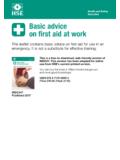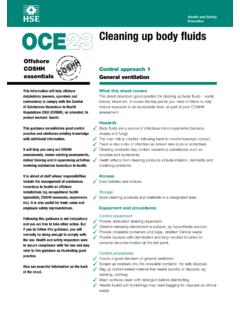Transcription of Protect Your Employees with an Exposure Control Plan
1 TIPS uufor Improving Yo r Exposure Control plan Protect your For Further Information CDC: Employees with an The Centers for Disease Control someone responsible for Use safer sharps that help guidelines on what type of PPE NIOSH: NIOSH BBP: Exposure Control plan and Prevention (CDC) NIOSH implementing the plan . avoid the chance of should be used and when and recently visited a sample of jails Exposure . Although most how different PPE should be topics/bbp/correctional and prisons around the country Provide a complete list of correctional facilities have used. PPE includes disposable OSHA: and identified a number of jobs and procedures where adopted new, safer sharps, gloves, masks, eye protection, OSHA BBP: problems with the Exposure Employees are at high risk traditional needles or lancets face shields, gowns, aprons, Control Plans it reviewed.
2 Here of Exposure . Some Exposure were used for some procedures. other protective clothing, and are some tips on how to avoid CPR mouthpieces. Under OSHA: Model Plans and Programs Control Plans did not include these problems. Review your an employee Exposure Be specific about how to normal conditions of use for the Bloodborne Pathogens and Hazard Communications plan to see if it has any of these determination a list of job implement controls. appropriate PPE does not permit defects. If it does, revise the classi fications and specifi c While most Exposure Control blood or other infectious Standards, Plans specified work practices materials to pass through or plan to fix the problems.
3 Procedures or tasks in which to Control exposures to reach the workers outer workers may be exposed to Provide a written plan . blood and other potentially bloodborne pathogens, many clothing, undergarments, skin, were not specific about how to eyes, mouth, or other mucous A few jails did not have a infectious materials on the job. implement those controls. For membranes. written Exposure Control plan . Where such lists were present, example, the plan may state A written plan is the basis some jobs were not included for an eff ective bloodborne ( , dentists were often pathogens program. missing). Tell workers that you have a plan and where it is Get workers input in the located.
4 Some health care selection of new devices. workers did not know their Many facilities did not eff ectively facility had an Exposure Control involve workers or did not plan . This should be covered describe the device selection during the annual bloodborne process in the Exposure Control pathogens training. Plans. your Exposure Control plan should describe how your Designate a person to facility evaluates new, safer implement the plan . devices ( , sharps devices) and A few Exposure Control how you involve the workers Plans did not designate in this process. that work surfaces will be Identify the person decontaminated but does not responsible for state how that decontamination implementing the hepatitis will be conducted or how often.
5 B vaccination policy and Similarly, procedures for hand ling the steps workers must contam inated laundry and take for vaccination. If a equipment were often vague. worker declines to receive the vaccination, he or she must Clarify how personal sign a declination form. Many protective equipment (PPE) Exposure Control Plans lacked a can help. While everyone had declination form. gloves available, other types of PPE were not always provided REMEMBER: Update your and were sometimes Exposure Control plan inaccessible. Th e Exposure every year, and get the Control plan should provide updates into every copy! To receive NIOSH documents or information about occupational safety and health topics contact NIOSH at Telephone: 1 800 CDC INFO (1 800 232 4636) Text telephone (TTY): 1 888 232 6348 E-mail: or visit the NIOSH Web site at For a monthly update on news at NIOSH, subscribe to NIOSH eNews by visiting DHHS (NIOSH) Publication No.
6 2007 158 September 2007 Workplace Safety and Health your first line of defense against bloodborne pathogens. Workplace Safety and Health Correctional health care settings present unique Exposure scenarios because of the high rates of diseases among incarcerated populations and the potential for unpredictable behavior. Correctional health care workers may be exposed to blood and other potentially infectious materials in their jobs. This puts them at increased risk for contracting bloodborne pathogen infections, including hepatitis B virus, hepatitis C virus, and A comprehensive bloodborne pathogens Exposure prevention program will help Protect your health care Employees .
7 One component of a bloodborne pathogens Exposure prevention program is a written Exposure Control plan . These plans are required by the Occupational Safety and Health Administration (OSHA) bloodborne pathogens standard. In addition, local regulations, employer policy, or collective bargaining agreements may call for such a program. What is an Exposure Control plan ? by Why is an Exposure Control plan Important? of an Exposure Control plan Written policy for protecting Employees from bloodborne pathogens exposures Administration of bloodborne pathogens program Be sure to designate a responsible individual. Employee Exposure determination Include a list of all job classifications in which Employees are most likely exposed to blood and body fluids and a second list of job classifications in which Employees may be exposed to blood and body fluids.
8 Hepatitis B vaccination provisions Universal precautions Treat all blood and other body fluids as if they are infectious. Employee education and training Be sure to include both initial and annual training. Facility-specific methods for Control of bloodborne pathogens Engineering controls ( , safer sharps) Work practice controls (housekeeping, hand washing, labeling, and disposal procedures) Personal protective equipment (PPE) Post- Exposure reporting, evaluation, counseling, and followup procedures Procedures for evaluating circumstances surrounding an Exposure incident Recordkeeping, including compliance monitoring and annual plan updates your Exposure Control plan must be: , human immuno deficiency virus.
9 An Exposure Control plan is the focal point of any bloodborne pathogens Exposure prevention program. It details in writing your plan for reducing exposures to blood and explains what steps to take if an Exposure occurs. The plan specifies all steps taken your facility to Protect your workers. First and most important your Exposure Control plan helps you Protect your workers from Exposure to bloodborne pathogens. Second, the cost of an Exposure incident can be signifi cant, including post- Exposure treatment and counseling, as well as loss of employee work time. If an employee does contract an illness, costs can dramatically escalate from increased worker s compensation and the training of a replacement.
10 The plan helps you Control these costs by reducing the risk of Exposure to bloodborne pathogens. Third, if your workers are at risk for a bloodborne pathogens Exposure , you are required by the law to have a written Exposure Control plan . Basic Elements your Exposure Control plan should include a description of how your facility meets each of the basic elements. your plan may also cover additional topics, such as how inmate workers and volunteers are protected. OSHA has developed a model Exposure Control plan entitled Model Plans and Programs for the OSHA Bloodborne Pathogens and Hazard Communications Standards. Use it as a template for your plan , but tailor it to the specific requirements of your facility.
















